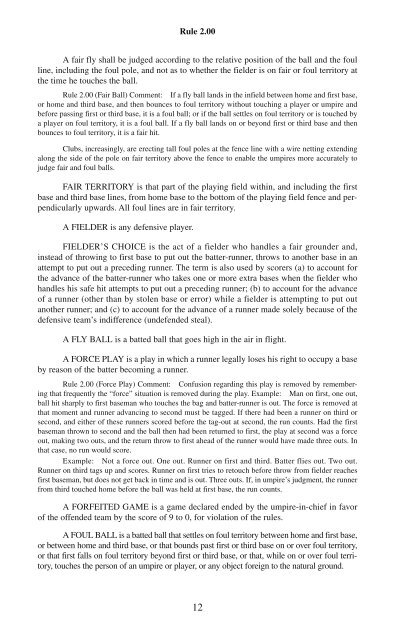OFFICIAL BASEBALL RULES
1SPD1Aq
1SPD1Aq
You also want an ePaper? Increase the reach of your titles
YUMPU automatically turns print PDFs into web optimized ePapers that Google loves.
Rule 2.00A fair fly shall be judged according to the relative position of the ball and the foulline, including the foul pole, and not as to whether the fielder is on fair or foul territory atthe time he touches the ball.Rule 2.00 (Fair Ball) Comment: If a fly ball lands in the infield between home and first base,or home and third base, and then bounces to foul territory without touching a player or umpire andbefore passing first or third base, it is a foul ball; or if the ball settles on foul territory or is touched bya player on foul territory, it is a foul ball. If a fly ball lands on or beyond first or third base and thenbounces to foul territory, it is a fair hit.Clubs, increasingly, are erecting tall foul poles at the fence line with a wire netting extendingalong the side of the pole on fair territory above the fence to enable the umpires more accurately tojudge fair and foul balls.FAIR TERRITORY is that part of the playing field within, and including the firstbase and third base lines, from home base to the bottom of the playing field fence and perpendicularlyupwards. All foul lines are in fair territory.A FIELDER is any defensive player.FIELDER’S CHOICE is the act of a fielder who handles a fair grounder and,instead of throwing to first base to put out the batter-runner, throws to another base in anattempt to put out a preceding runner. The term is also used by scorers (a) to account forthe advance of the batter-runner who takes one or more extra bases when the fielder whohandles his safe hit attempts to put out a preceding runner; (b) to account for the advanceof a runner (other than by stolen base or error) while a fielder is attempting to put outanother runner; and (c) to account for the advance of a runner made solely because of thedefensive team’s indifference (undefended steal).A FLY BALL is a batted ball that goes high in the air in flight.A FORCE PLAY is a play in which a runner legally loses his right to occupy a baseby reason of the batter becoming a runner.Rule 2.00 (Force Play) Comment: Confusion regarding this play is removed by rememberingthat frequently the “force” situation is removed during the play. Example: Man on first, one out,ball hit sharply to first baseman who touches the bag and batter-runner is out. The force is removed atthat moment and runner advancing to second must be tagged. If there had been a runner on third orsecond, and either of these runners scored before the tag-out at second, the run counts. Had the firstbaseman thrown to second and the ball then had been returned to first, the play at second was a forceout, making two outs, and the return throw to first ahead of the runner would have made three outs. Inthat case, no run would score.Example: Not a force out. One out. Runner on first and third. Batter flies out. Two out.Runner on third tags up and scores. Runner on first tries to retouch before throw from fielder reachesfirst baseman, but does not get back in time and is out. Three outs. If, in umpire’s judgment, the runnerfrom third touched home before the ball was held at first base, the run counts.A FORFEITED GAME is a game declared ended by the umpire-in-chief in favorof the offended team by the score of 9 to 0, for violation of the rules.A FOUL BALL is a batted ball that settles on foul territory between home and first base,or between home and third base, or that bounds past first or third base on or over foul territory,or that first falls on foul territory beyond first or third base, or that, while on or over foul territory,touches the person of an umpire or player, or any object foreign to the natural ground.12


